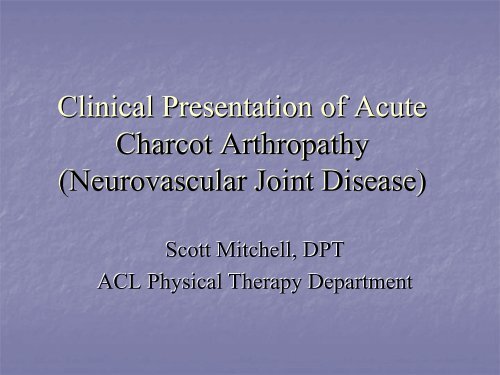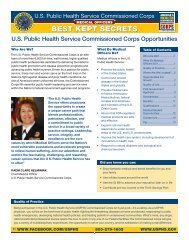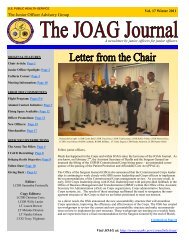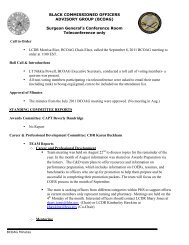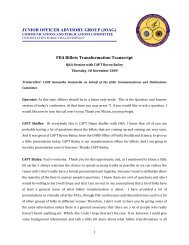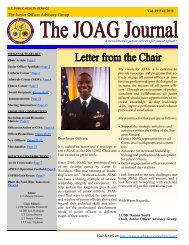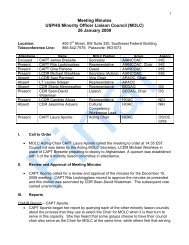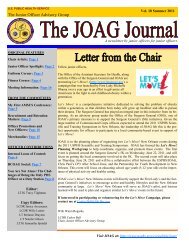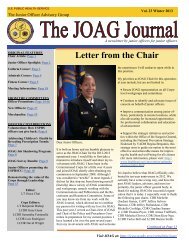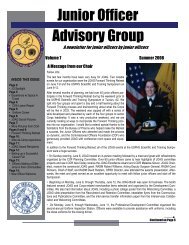Acute Clinical Presentation of Charcot Arthropathy
Acute Clinical Presentation of Charcot Arthropathy
Acute Clinical Presentation of Charcot Arthropathy
Create successful ePaper yourself
Turn your PDF publications into a flip-book with our unique Google optimized e-Paper software.
<strong>Clinical</strong> <strong>Presentation</strong> <strong>of</strong> <strong>Acute</strong><br />
<strong>Charcot</strong> <strong>Arthropathy</strong><br />
(Neurovascular Joint Disease)<br />
Scott Mitchell, DPT<br />
ACL Physical Therapy Department
Discovery <strong>of</strong> <strong>Charcot</strong> Joint Disease<br />
• Jean-Martin <strong>Charcot</strong>, French neurologist – in 1868 discovered<br />
a link between neurosyphilis and a particular kind <strong>of</strong> deformed<br />
joint.<br />
• Initially he thought it was a deformity due to a “spontaneous<br />
fracture,” but later realized it might be a chronic process<br />
related to neuropathy.
disease<br />
Etiology <strong>of</strong> <strong>Charcot</strong> joint disease<br />
Two main theories, both probably play a significant role:<br />
Neurovascular theory (French):<br />
• Dysregulated autonomic nervous system <br />
hyperemia - desensitized joints receive increased blood flow increased<br />
osteoclastic resorption <strong>of</strong> bone<br />
Neurotraumatic theory (German):<br />
• loss <strong>of</strong> peripheral sensation and proprioception <br />
repetitive microtrauma <br />
inflammatory resorption <strong>of</strong> traumatized bone<br />
Together these lead to an increased susceptibility to fractures and joint damage
Prevalence in diabetic patients<br />
<strong>Charcot</strong> joint disease most prevalent in neurosyphilis (tabes dorsalis) when<br />
originally discovered.<br />
Other neurologic conditions associated c <strong>Charcot</strong> neuroarthropathy:<br />
alcoholism, leprosy, syringomyelia, pernicious anemia, <strong>Charcot</strong>-Marie-<br />
Tooth disease, poliomyelitis, trauma to peripheral nerves or spinal cord<br />
In 1936, physicians discovered the link between <strong>Charcot</strong> joint disease and<br />
diabetic neuropathy. DM is now the most frequent condition associated c<br />
this condition.<br />
7% <strong>of</strong> DM patients, 29% <strong>of</strong> those c diabetic neuropathy are affected.<br />
Related to long-term poor glucose control.
<strong>Clinical</strong> signs and symptoms <strong>of</strong> <strong>Charcot</strong> foot<br />
• History <strong>of</strong> fall, sprain, or direct trauma<br />
• May be painless because <strong>of</strong> diabetic neuropathy or painful if sensory<br />
neuropathy is not complete<br />
• Unilateral lower extremity warmth, redness, and/or edema<br />
• Depressed medial arch, “rocker- bottom” foot or other visible deformity<br />
• “Bounding” pedal pulses; no systemic signs <strong>of</strong> infection<br />
• MHx: Pt has longstanding uncontrolled DM and sensory neuropathy
<strong>Clinical</strong> signs and symptoms <strong>of</strong> <strong>Charcot</strong> foot<br />
Differential diagnosis:<br />
• Cellulitis<br />
• Deep vein thrombosis (DVT)<br />
• Osteomyelitis<br />
Misdiagnosis can lead to:<br />
• Unnecessary incision and drainage<br />
• Inappropriate treatment c antimicrobial therapy<br />
• Continued WB on affected extremity, additional bony destruction<br />
and foot deformity
Joints affected<br />
1)Tarsometatarsal joint (TMT or Lis-Franc’s joint) – about 60%<br />
2)Metatarsophalangeal joint (MTP) – about 30%<br />
3)Talocrural joint (ankle mortise) – about 10%
Stages <strong>of</strong> <strong>Charcot</strong> joint disease (Eichenholtz(<br />
stages)<br />
• Stage 0: Typically there is joint edema, but radiographs are negative. A<br />
bone scan or MRI may pick up a <strong>Charcot</strong> joint at this stage.<br />
• Stage 1: “<strong>Acute</strong> <strong>Charcot</strong>” – Osseous fragmentation and joint dislocation<br />
seen on radiograph<br />
• Stage 2: Decreased local edema, coalescence <strong>of</strong> fragments and absorption<br />
<strong>of</strong> fine bone debris<br />
• Stage 3: No local edema, with consolidation and remodeling (deformed) <strong>of</strong><br />
fracture fragments. The foot is now stable.
‘Normal’ foot radiographs: Lateral and AP views.<br />
Lateral: Note presence <strong>of</strong> arch<br />
and distinct margins/borders<br />
<strong>of</strong> bones as they articulate c<br />
other bones.<br />
AP View: Again, noteworthy<br />
is the distinction between<br />
bone articulations. TMT<br />
joint is ‘clear’, not hazy or<br />
crumbled.
<strong>Charcot</strong> foot: Destroyed tarsometatarsal (TMT) joints (Lisfranc’s<br />
joint), with fracture and dislocation <strong>of</strong> fragments.<br />
AP<br />
View<br />
Oblique<br />
View
<strong>Charcot</strong> foot: Loss <strong>of</strong> arch and acquired pes planus deformity<br />
Lateral view
Notice the significant difference <strong>of</strong> L vs. R foot as the pt presents<br />
ents<br />
for evaluation – unilateral foot and leg edema, visible L foot<br />
deformity.
These are the X-ray X<br />
films <strong>of</strong> the<br />
L foot for the same patient.<br />
Notice bony destruction at the TMT joints<br />
and mid-shaft metatarsals.
Bony foot deformity creates areas <strong>of</strong> bony<br />
prominence that were not previously<br />
present. These bony prominences,<br />
combined c ongoing sensory<br />
neuropathy, can lead to a high<br />
incidence <strong>of</strong> pressure ulceration,<br />
subsequent infection, and possible<br />
need for foot or limb amputation.
<strong>Charcot</strong> treatment plan<br />
• Recognize the condition<br />
• Appropriate imaging and referrals<br />
• Off-load the joint, immobilization, NWB<br />
• Stabilization (casting) until bones stabilize<br />
• Appropriate custom footwear to accommodate deformity once stable<br />
• Pharmacologic therapy:<br />
Bisphosphonates – limited but promising research into using these in acute<br />
phase <strong>of</strong> <strong>Charcot</strong> joint disease to minimize bony resorption
Treatment goals<br />
• Reduce degree <strong>of</strong> fracture and deformity<br />
• Reduce risk <strong>of</strong> future wounds and/or amputation<br />
• Limit morbidity<br />
Left untreated, some possibilities are:<br />
• Joint deformity<br />
• Ulceration +/- infection<br />
• Loss <strong>of</strong> function<br />
• Amputation<br />
Treatment time: May take 6-9 mos. for edema and erythema <strong>of</strong> affected joint<br />
to recede and bones to stabilize.
Cam/fracture walker
Casts – short-leg or total contact
CROW (<strong>Charcot</strong> Restraint Orthotic Walker)
Total contact orthosis and custom DM shoes
Selected ACL cases<br />
November 2006 through January 2008<br />
November 2006 through January 2008
Case #1<br />
55 y/o diabetic male – presented to ER c c/o R lower leg and foot swollen and<br />
painful since previous evening. No known MOI.<br />
PMH: DM, HTN, ESRD (PD), PVD, Peripheral neuropathy<br />
Upon further questioning, pt remembered having increasing leg and foot<br />
swelling x 2-3 weeks.<br />
PT staff called to come give assessment and recommendations. Pt had edema<br />
in R lower leg and ‘bowing out’ <strong>of</strong> plantar surface <strong>of</strong> foot. No increased<br />
warmth, redness, wounds, or drainage.<br />
Recommendation: send pt to radiology for foot and ankle films to r/o <strong>Charcot</strong><br />
foot – presentation not consistent c cellulitis.<br />
PT Rx: Pt issued Ace wrap to try and help control swelling in R LE. Pt<br />
instructed on treatment plan <strong>of</strong> NWB while casted for months if <strong>Charcot</strong><br />
foot was found. Pt instructed to keep routine appt. c PCP 4 days later.
Case #1<br />
Initial films:<br />
Ankle and chest films were requested/obtained. Foot films were not done.<br />
Radiology report:<br />
No acute fxrs found. However, “whiskering” <strong>of</strong> distal aspect <strong>of</strong> medial<br />
malleolus was noted, possibly suggestive <strong>of</strong> prior avulsion injury.<br />
ER Rx: Pt given dose <strong>of</strong> IV antibiotics and sent home ambulatory.
Case #1<br />
Visit c PCP 4 days p presentation to ER:<br />
Pt reported light-headedness. Pt reported lack <strong>of</strong> sensation in R foot. Random<br />
blood glucose >600. R leg and foot still edematous, but not warmer than L.<br />
MD Rx: Pt sent back to radiology. Three views <strong>of</strong> foot (not ankle) were<br />
obtained.
Case #1: AP View: Healing 2 nd metatarsal fxr c bony callus and<br />
collapse <strong>of</strong> TMT joints c bony fragmentation.
Case #1: Oblique View: Note same 2 nd metatarsal fxr c callus and<br />
TMT destruction.
Case #1: Lateral view: TMT joint destruction visible here also c collapse <strong>of</strong> the<br />
arch and s<strong>of</strong>t tissue prominence on plantar foot. (Plantar heel spur is only an<br />
incidental finding.)
Case #1: Rx<br />
Pt was sent to podiatry, short-leg cast was placed, strict NWB instruction.<br />
Many f/u visits c podiatry to monitor bony healing and change cast.
Case #2<br />
72 y/o female already going to PT for monthly DM foot care for one year prior<br />
to foot “problems.”<br />
At monthly foot care f/u visit, pt c/o R ankle pain and reported having had a<br />
fall/trip 4 mos. previously. She had not reported this previously nor sought<br />
medical attention.<br />
Physical exam: R ankle joint appeared edematous vs. L and there appeared to<br />
be a prominence (bony) on the lateral plantar surface <strong>of</strong> the R foot.<br />
Pt sent to radiology for radiographs <strong>of</strong> B feet and ankles.
Case #2: L foot AP and Oblique views
Case #2: Lateral view <strong>of</strong> L foot.
Case #2: Radiographic Findings L foot<br />
“Mild hallux valgus deformity c mild degenerative OA to 1 st MTP joint”<br />
“Healed fracture involving 4 th distal metatarsal neck”<br />
“No evidence <strong>of</strong> acute fractures nor dislocations… there is evidence <strong>of</strong> severe<br />
PVD… Osteoporosis probably secondary to pt’ diabetes… No signs <strong>of</strong><br />
neurovascular joint disease… pt is flatfooted consistent c pes planus.”
Case#2 R foot AP and Oblique views
Case #2: R foot lateral view
Case #2: Radiographic findings R foot/ankle<br />
“Ankle mortise is anatomic”<br />
“Severe PVD”<br />
“considerable abnormally increased sclerosis, disorganization, debris,<br />
fragmentation, and collapse <strong>of</strong> the midfoot. This is consistent c a severe<br />
pes planus secondary to moderate to severe neurovascular joint disease…”<br />
“partial collapse <strong>of</strong> the navicular and almost complete collapse <strong>of</strong> the lunate…<br />
partial collapse <strong>of</strong> the 1 st , 2 nd , and 3 rd cuneiforms c joint destruction and<br />
disorganization…”<br />
“The talus has migrated forward into the distal tarsal row.”
Case #2: Rx<br />
• Fractures/<strong>Charcot</strong> foot found<br />
• DVT ruled-out c ultrasound<br />
• Pt sent to podiatry:<br />
• short-leg cast placed<br />
• NWB<br />
• pt instructed to elevate leg<br />
• F/u c podiatry q 2 weeks to monitor bony healing and make decision regarding<br />
when WB appropriate<br />
• Short-leg cast d/c’d 3 mos. Later, short cam walker placed (by podiatry), cont.<br />
using w/c.<br />
• Currently short cam walker s w/c for short distances, still use w/c for longer<br />
distances.
Case #3<br />
46 y/o male already under care <strong>of</strong> PT for a stage 3 pressure ulcer on R foot<br />
(MTH #1)<br />
Pt c/o L foot warmth, redness, pain, and swelling. Pt had started using Ace<br />
wrap on L foot to try and reduce edema.<br />
Physical exam: Increased redness, warmth, and dorsal foot edema noted on L<br />
foot vs. R.<br />
Pt was sent to radiology for radiographs <strong>of</strong> L foot.
Case #3: L foot lateral view
Case #3: L foot<br />
Oblique view
Case #3: L foot<br />
ot<br />
AP view
Case #3: Radiographic Findings<br />
“Questionable s<strong>of</strong>t tissue swelling over dorsum <strong>of</strong> foot..”<br />
“No signs <strong>of</strong> fractures, dislocations, no evidence <strong>of</strong> osteomyelitis or a bone<br />
destructive process.”<br />
“Severe peripheral vascular disease beyond the patient’s age strongly<br />
consistent c diabetes.”<br />
Bottom line: “By plain film evidence, there is no evidence for developing<br />
neurovascular joint disease at this point. MRI is more sensitive. If<br />
warranted, this should be considered.”
Case #3: Rx<br />
PT called Dr. Mirmiran, podiatrist, to discuss case. Asked podiatrist about her<br />
interpretation <strong>of</strong> “Stage 0 <strong>Charcot</strong> foot” compared c this pt and what Rx she<br />
would recommend.<br />
Pt referred to podiatry by PCP after discussion c PT and podiatrist.<br />
Short leg cast was placed on L leg by podiatrist. Initially NWB c crutches,<br />
then pt given walking shoe for use c cast and crutches.<br />
Cast changed by podiatrist q 2 weeks while she took serial radiographs and<br />
also monitored redness and edema <strong>of</strong> L foot.
Case #4 Case #4<br />
61 y/o male had been referred to PT by ER 3 mos. previously for wound care<br />
for L ring finger and “shoe padding and care causing R medial foot and<br />
ankle pain.” PT unable to reach pt after repeated phone calls and a letter. er.<br />
Pt eventually contacted PT (3 mos. later); referral had to be tracked down in<br />
medical record to find out why the e pt had been referred. Pt has<br />
longstanding uncontrolled DM, HTN, dialysis x 3 years.<br />
Pt denied ed having any wounds on fingers – he had had dry gangrene and had no<br />
open wounds upon presentation to PT.<br />
Pt c/o “burning” from R medial foot/ankle up medial aspect <strong>of</strong> R tibia. Also<br />
c/o occasional swelling in R foot. Pt c/o pain in R foot and lower leg<br />
“when I step on it.”<br />
Pt denied ed any specific c MOI, but said that about 4 mos. previously y he was<br />
walking for 1-1.51.5 miles – started limping and felt a burning sensation and<br />
aching in R foot. Pt denied having any pain sitting in PT for eval.
Case #4: Physical Exam<br />
Bony prominence <strong>of</strong> R medial midfoot and ankle noted. Clawing <strong>of</strong> B toes #2-<br />
5, s/p R great toe amputation, prominent plantar metatarsal heads.<br />
No swelling or redness noted.<br />
R ankle/foot warm to the touch vs. L.<br />
Thermistor (IR) skin temp. L R<br />
Lateral ankle 87.1 92.4<br />
Anterior ankle 89.8 93.7<br />
Medial ankle 88.9 94<br />
Dorsum <strong>of</strong> foot 89.7 93.1<br />
Immediate Rx:<br />
1)Cam walker issued to pt for use c any walking. Pt said this decreased his<br />
pain.<br />
2)Radiographs <strong>of</strong> R foot/ankle ordered by PCP.
Case #4: R ankle films
Case #4: R ankle lateral view
Case #4:<br />
R foot AP view
Case #4: R foot<br />
Oblique view
Case #4 Radiographic findings<br />
“Diffuse atherosclerosis compatible c DM or renal disease”<br />
“Prior amputation <strong>of</strong> distal phalanx and distal portion <strong>of</strong> proximal phalanx <strong>of</strong><br />
first toe”<br />
“Medial and inferior displacement <strong>of</strong> the navicular bone relative to the talus.<br />
The navicular bone is increased in density, and there is disorganization <strong>of</strong><br />
the bones <strong>of</strong> the midfoot. Sclerosis is present involving the proximal<br />
cuboid, the navicular, and distal talus and calcaneus. These findings are<br />
compatible c developing <strong>Charcot</strong> midfoot.”
Case #4: Rx<br />
Referral to podiatry written by PCP the following day, seen by Dr. Mirmiran 6<br />
days later.<br />
Repeat X-rays taken by podiatry, who concurred c Dx <strong>of</strong> <strong>Charcot</strong> foot.<br />
Fragmentation <strong>of</strong> navicular; TMT joints okay, mild changes over talar<br />
head.<br />
L foot/ankle films also taken – normal.<br />
Short leg cast placed – NWB c either crutches or w/c.<br />
Cast changed 3 times (q 2 weeks) while fxr healing, then scrip. written for<br />
custom DM shoes (by podiatry).
Case #5<br />
60 y/o female c PMH <strong>of</strong> being admitted to ACL ~10x in the past for cellulitis<br />
<strong>of</strong> either the R or L side.<br />
Pt presented to ACL ER/walk-in c/o R leg swelling and pain x 1 week.<br />
Initial radiographs were taken <strong>of</strong> R tibia. Neither ankle nor foot films were<br />
ordered. Labs were drawn. Pt was started on antibiotics (suspicion was<br />
cellulitis).<br />
Two days later, venous doppler was done to r/o DVT.
Case #5: Tibia radiograph report<br />
“Diffuse s<strong>of</strong>t tissue swelling over entire visualized right lower extremity”<br />
“No bony abnormalities. No bone destructive lesions nor abnormal periosteal<br />
reactions to suggest osteomyelitis by plain film.”
Case #5<br />
Pt called PT 6 days prior to being seen in PT (for routine DM foot care visit)<br />
reporting inability to bear weight on R foot. (This was 13 days after<br />
starting treatment for cellulitis.) PT consulted c PCP, who recommended<br />
that pt go through walk-in/ER. This information was conveyed to pt by<br />
phone.<br />
Pt went to ACL ER c/o R leg warmth, pain, redness. She reported inability to<br />
stand on R foot. She had just completed course <strong>of</strong> Bactrim the day prior.<br />
No X-rays were taken. CBC and blood culture were ordered. Pt given IV<br />
antibiotics, treated daily for 3 days.
Case #5: PT appointment<br />
Pt came to PT 6 days later in w/c saying that she was having trouble/pain<br />
bearing weight on R foot, even a few steps, so she had started using her<br />
w/c. Appt. was for DM foot care and f/u <strong>of</strong> chronic LE edema.<br />
“I can’t even step on it.” 4/10 pain at rest, 10/10 pain c WB.
Case #5: PT evaluation<br />
Girth measurements L R<br />
Calf 41.2cm 42cm<br />
Ankle 23.1cm 23.4cm<br />
Thermistor (IR) skin temp. L R<br />
Dorsum <strong>of</strong> foot 89.1 87.9<br />
Anterior ankle 89.2 93.1<br />
Medial ankle 87.1 93.5<br />
Lateral ankle 88.8 92.5<br />
Also noted: routine DM foot care: onychomycosis, callus B heels, dried blood<br />
blister R plantar MTH #2<br />
Immediate Rx: toenail/callus debridement, cam walker issued to pt (better than<br />
nothing), pt sent to radiology for R foot/ankle films to r/o <strong>Charcot</strong> foot or<br />
other bony destructive process<br />
Pt instructed to elevate R LE, limit WB
Case #5: R foot AP/oblique radiographs
Case #5: R foot lateral radiograph
Case #5: R foot radiographic findings<br />
“Edema in the foot is also present, and there is mild deformity <strong>of</strong> the proximal<br />
phalanx <strong>of</strong> the second digit which is felt to represent the result <strong>of</strong> prior<br />
injury. Dorsal s<strong>of</strong>t tissue swelling over the distal metatarsals is present.”
Case #5: R ankle radiographs
Case #5: R ankle<br />
lateral view
Case #5: Ankle radiographic findings<br />
“This examination is markedly abnormal. There are fractures <strong>of</strong> both the<br />
medial and lateral malleoli c lateral and anterior displacement <strong>of</strong> the talar<br />
dome relative to the distal tibia.<br />
…there is marked irregularity <strong>of</strong> the distal tibial articular surface with<br />
extensive areas <strong>of</strong> lytic destruction and sclerosis <strong>of</strong> the tibia.<br />
Increased density involving the talar dome and distal tibia is also present.”<br />
“Though these findings could be the result <strong>of</strong> a neuropathic joint, osteomyelitis<br />
cannot be excluded…”
Case #5: Rx (1)<br />
Pt instructed to NOT bear weight on R LE until further f/u.<br />
Podiatry/ortho. consult written by PCP.<br />
Pt seen the following day by podiatry, and remained in w/c and cam walker.<br />
Pt’s desire was to have surgery to be able to walk again.<br />
Cardiology clearance and vascular status studies (AVI/TBI and arterial flow<br />
studies) were necessary prior to surgery.<br />
About 3 weeks p initial radiograph findings <strong>of</strong> bimalleolar fxr, external<br />
fixation was performed to R ankle.
Case #5: external fixation
Case #5: External fixator ankle films<br />
“Views <strong>of</strong> the ankle are almost impossible to interpret due to the extensive<br />
overlying orthopedic metallic hardware. Previous ORIF c external wire<br />
transfixing devices is appreciated. This totally obscures radiographic<br />
assessment <strong>of</strong> the ankle mortise itself. Diffuse s<strong>of</strong>t tissue swelling is<br />
evident.”
Case #5: Rx<br />
Infection in R leg despite fixation.<br />
Failed attempt to correct fxrs c fixation.<br />
Pt underwent below knee amputation.
Case #6<br />
58 y/o female who presented to OPD-2 c c/o “My foot went flat.”<br />
PMH: uncontrolled Type 2 DM, ASCVD, ESRD (hemodialysis), HTN<br />
Pt reports having a lump on R foot arch x 3-4 mos. Pt admits having DM<br />
shoes and said she normally wore them, but was not wearing them when<br />
seen for appt., saying she had lost one <strong>of</strong> them.<br />
Pt was sent to radiology at request <strong>of</strong> medical assistant for bilateral foot films.
Case #6: L foot AP/oblique views
Case #6: L foot<br />
lateral view
Case #6: R foot AP/oblique views
Case #6: R foot<br />
t<br />
lateral view
Case #6: Radiographic findings<br />
“Marked asymmetrical joint space irregularity involving R midfoot …<br />
1 st /2 nd cuneiforms, 1 st , 2 nd , 3 rd , 4 th , perhaps 5 th metatarsal articulations<br />
at the bases.”<br />
Bony erosions, increased sclerosis, debris from navicular to metatarsal<br />
bases.<br />
Early partial collapse <strong>of</strong> R mid-arch.<br />
Small inferior bilateral calcaneal spurs are an incidental finding.
Case #6: Rx<br />
Referral to podiatrist at orthopedic clinic written by PT, cosigned by clinical<br />
director, scheduled by Contract Health.<br />
Cam walker issued by PT c instructions for pt to use w/c and NOT walk –<br />
NWB – until assessed by podiatry.<br />
Podiatry placed short-leg cast on R leg, NWB status (w/c).
<strong>Clinical</strong> signs and symptoms <strong>of</strong> <strong>Charcot</strong> foot<br />
• History <strong>of</strong> fall, sprain, or direct trauma<br />
• May be painless because <strong>of</strong> diabetic neuropathy or painful if sensory<br />
neuropathy is not complete<br />
• Unilateral lower extremity warmth, redness, and/or edema<br />
• Depressed medial arch, “rocker- bottom” foot or other visible deformity<br />
• “Bounding” pedal pulses; no systemic signs <strong>of</strong> infection<br />
• MHx: Pt has longstanding uncontrolled DM and sensory neuropathy
<strong>Charcot</strong> foot/ankle initial Rx<br />
(when suspected)<br />
• Rule-out cellulitis and/or DVT if suspected<br />
• NWB until deemed unnecessary (crutches work unless pt<br />
already has w/c)<br />
• Order ankle AND foot films <strong>of</strong> at least affected side, maybe<br />
other side for comparison<br />
• Consider cam walker for temporary use<br />
• Look at X-ray films – sometimes it’s glaringly obvious,<br />
sometimes a call to radiology is necessary to make initial<br />
determination<br />
• Referral to podiatry/ortho. as appropriate
Treatment progression (podiatry)<br />
• Short-leg cast or total contact cast<br />
• CROW or clamshell brace (possibly)<br />
• Custom DM shoes and/or braces to prevent future<br />
wounds/infection/amputation<br />
• This will give the best results, but is not a guarantee that new<br />
fxrs will never happen or that wounds will never develop.


